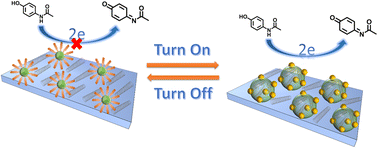A novel temperature-responsive electrochemical sensing platform for reversible switch-sensitive detection of acetamidophenol†
Abstract
A novel facile, quick, and temperature-controlled sensor was constructed based on a polystyrene-poly-N,N-diethyl acrylamide-polystyrene (PS-PDEAM)/carboxylated multi-walled carbon nanotube (MWCNT) composite modified glass carbon electrode. The sensor achieves acetaminophen (AP) reversibility through better temperature sensitivity. PS-PDEAM shrinks when the temperature exceeds its lower critical temperature (LCST). When AP molecules pass through the modified interface, the electron transfer rate is accelerated, and the sensor is turned on. In the off state, the electrochemical response of AP cannot be detected. Under ideal experimental conditions, for composite modified films, there is a wide detection range of AP between 1.5–85.1 μM and 85.1–235.1 μM, and the limit of detection of acetaminophen is as low as 0.57 μM (S/N = 3). This method has been successfully applied to the determination of AP in tablets, and shows high stability, good reproducibility and excellent anti-interference ability. The on-off sensor opens up a wide range of possibilities for the use of temperature-sensitive polymers in electro-catalysis, sensors, and environmental pollutant monitoring.



 Please wait while we load your content...
Please wait while we load your content...